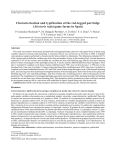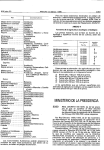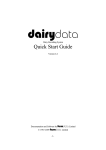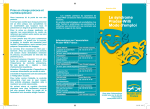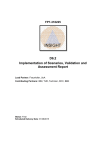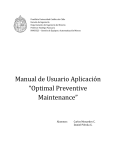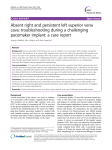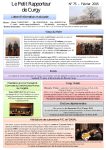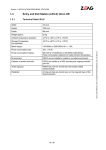Download - Small Ruminant Research
Transcript
Small Ruminant Research 47 (2003) 133–143 Characterization of semi-extensive goat production systems in southern Spain J.M. Castel a,∗ , Y. Mena a , M. Delgado-Pertı́ñez a , J. Camúñez b , J. Basulto b , F. Caravaca a , J.L. Guzmán-Guerrero c , M.J. Alcalde a a b Departamento de Ciencias Agroforestales, Escuela de Ingenierı́a Técnica Agrı́cola, Universidad de Sevilla, Ctra. Utrera km. 1, 41013 Sevilla, Spain Departamento de Economı́a Aplicada I, Facultad de Ciencias Económicas y Empresariales, Universidad de Sevilla, Avda. Ramón y Cajal 1, Sevilla, Spain c Departamento de Ciencias Agroforestales, Escuela Politécnica Superior, Universidad de Huelva, Campus Universitario de la Rábida, 21819 Palos de la Frontera, Huelva, Spain Accepted 26 October 2002 Abstract This study attempts to describe the semi-extensive goat farming sector in Andalusia (south of Spain) and to establish characteristics. Eighty-nine goat farmers were surveyed in three areas of this region. The survey examined all aspects of the systems, from socio-economy to management. A multivariate analysis (multiple correspondence and cluster) was used to determine the different farm characteristics. Most of the goat farms studied are single-worker or family managed. The farmers lack training and are elderly, so that continuity of the activity is not assured, although newcomers are usually young. All the farms have some area in ownership, although the farms most specialized in dairy goat products are the smallest in both ownership and total area. The roads are generally in good condition, except on farms with little land, situated in areas of the sierra. Machine-milking installations, closely related to the presence of infrastructures and of goats with a dairy tendency, are generally lacking, (this aspect is improving day by day). Artificial nursing is less generalized than machine-milking. Farms specializing in milk production, whose main activity is dairy goat farming, have dairy specialized breed or crossbred (milk and meat) goats. Feeding depends largely on grazing, with little area being cultivated to produce feed for the goats. Little distinction is made for the production level. Olive or acorn tree branches (Quercus ilex spp.) are used as feedstuff, depending on the types of tree predominating in the area. Five farm types were established, the differences depending on 14 variables of socio-economic aspects, level of production, infrastructure and installations, and feeding. Generated information from this study entails an advance into knowledge of goat farming systems in the Mediterranean area (where little information is generated). The relevance of this study is important since Andalusia has 40% of goats in Spain that produce more than half of the total goat milk in the country, which points out the socio-economical importance for most depressed areas in the region. This work supposes previous steps for improving the semi-extensive goat farming sector. From a methodological point of view, the discussion on variable types and utility establishes farm type characteristics. © 2002 Elsevier Science B.V. All rights reserved. Keywords: Goat systems; Semi-extensive farming; Characterization methods; Southern Spain ∗ Corresponding author. Tel.: +34-954-486454; fax: +34-954-232644. E-mail address: [email protected] (J.M. Castel). 0921-4488/02/$ – see front matter © 2002 Elsevier Science B.V. All rights reserved. PII: S 0 9 2 1 - 4 4 8 8 ( 0 2 ) 0 0 2 5 0 - X 134 J.M. Castel et al. / Small Ruminant Research 47 (2003) 133–143 1. Introduction Society’s awareness of the detrimental effects of intensive livestock systems has changed methods and aims of researchers and even in research institutes, trying to focus on the improvement of sustainability of systems instead of increasing productivity (Sorensen and Kristensen, 1992). At this point, the continuity of semi-extensive systems without the loss of their traditional values (re-evaluation of little-productive land, environmental conservation) requires a good knowledge of their characteristics and of their strengths and weaknesses at the farm level and within the framework of the overall farming sector (Rubino and Haenlein, 1996). Currently, when scientific advance in animal production has been largely based on specialized research, Livestock Farming Systems (LSF) research in western Europe has tried to generate an integrated understanding of animal farming, product processing, and scientific bases for the evaluation of their overall efficiency (Gibon et al., 1999). According to the collective view of European LFS research (Gibon et al., 1996), one of the overall objectives is to increase knowledge about livestock farming systems and their diversity. According to this, some researchers (Gibon, 1994; Alvarez Funes and Paz Motola, 1997) emphasize the increasing interest in developing livestock farm characteristics. The aims of this study, in which three Andalusian areas have been selected as representative of semi-extensive goat farming with different degrees of intensification in each, were the following: • To analyze as a whole the three areas to obtain better knowledge of the reality of the Andalusian goat sector, which contributes to 51% of the goat milk produced in Spain. • To detect the main distinguishing elements of the different types of farms. • To establish, from the foregoing, different overall types of goat farms. This study is also a first step towards further projects with the following intentions: • To observe trends in the evolution of the different farming systems. • To plan possible actions in the systems leading to improved techniques and profitability, and at the same time, to improvements in the quality of life of the farmers, enabling the farms to persist. 2. Materials and methods This work has been carried out in the Andalusia region (southern Spain), particularly in the central and western part. The methodology used was an adaptation from Bourbouze (1995) and Alvarez Funes and Paz Motola (1997), with the following phases: (1) selection of samples and construction of the data-gathering instrument; and (2) information treatment and statistical processing, including the review and selection of variables for the analysis of types, application of multivariate statistical techniques (multiple correspondence and cluster), and analysis of variance and contingency tables. 2.1. Selection of samples and construction of the data-gathering instrument Climatically, Andalusia is a semi-arid Mediterranean region where rainfall distribution per year leaves short vegetative periods for annual plants and this offers little and seasonal grazing (Boza and Guerrero, 1994). Grazing resources also include tree species, shrubs and yearly plants with fall and spring growth. Herbs are the main forage resource, basically in fall and spring when rainfall occurs. This offers little and low quality in the rest of the year or in long dry periods. Three representative areas from this region were chosen where goats are farmed semi-extensively, all of them with a substantial dependence on the land basis but with different degrees of intensification. Zone 1, situated in the Sierra Norte of Seville, where the farms present a higher degree of extensification, similar to that in the other mountainous areas of western Andalusia. In this area, farming of goats is usually carried out together with other extensive species, and the goat breeds are mixed (milk and meat) or just meat-producing. Zone 2, comprising farms of the Málaga province, takes in the areas of Antequera, Montes de Málaga, Costa and Sierra del Torcal. Goats J.M. Castel et al. / Small Ruminant Research 47 (2003) 133–143 135 breeds are dairy, in particular the Malagueña breed, and systems are less dependent on grazing. Finally, zone 3, situated in the Sierra Norte of Cádiz, presents intermediate characteristics of intensification; the breeds are mixed and milk-producing. Farms of zones 1 and 3 belong to local cooperatives, and those of zone 2 belong to the Malagueña Pure Breed Association. Membership in any type of association was considered a priority when choosing the study areas, because it guaranteed greater cooperation. A questionnaire was designed, based on the one used by Falagán (1988). This comprised 216 items, grouped into the following sections: socio-economy, line of production, animal basis, land basis, infrastructure, installations and machinery, herd composition, reproductive and feeding management, hygiene, production, and commercialization. The questionnaires were completed between February 1998 and March 1999, needing visits of approximately 2–3 h to each of the 89 goat farmers. Surveyed farmers were chosen at random: 28 for the first zone, 21 for the second, and 40 for the third, representing 20% of the farmers for each zone. of perceptual maps. The quantitative variables were first converted into qualitative ones, introducing cuts in them. Taking the 73 variables as qualitative, their corresponding modalities were quantified, those most separated from the others being the ones that discriminate most between the units under study. Using the first 2 components (those with the greatest correlation and the largest number of variables) 34 of the initial 73 variables were selected, 11 of them are quantitative, and the other 23, qualitative. A hierarchical cluster analysis by the method of Ward, using the squared Euclidean distance, classifies the farms into five different types. 2.2. Information treatment and statistical processing 3. Results The field data were introduced into an Excel matrix after checking for missing and abnormal data. Subsequent statistical treatment was performed using the programs Excel and SPSS (SPSS, 1999). 2.2.1. Variable review and selection for type analysis and classification Of the total items, only 73 were used. The selection was made taking into account previous works (Castel et al., 1999, 2000; Mena et al., 1999) and removing variables which were not answered in all cases, those presenting little variability in their response, and those not supplying relevant zootechnical information. 2.2.2. Multivariate statistical technique application Multiple correspondence analysis was applied to the set of 73 variables. This is a technique of interdependence used for dimension reduction in the case of qualitative variables (Benzécri, 1992), similar to principal component analysis between quantitative variables, and which enables the visualization 2.2.3. Analysis of variance and contingency tables Comparison between the five types of different quantitative variables was performed using ANOVA. In the case of analysis of degree and sense of the relationship between qualitative variables, the corresponding contingency tables were constructed and the statistics calculated were used as basis for the Chi-squared distribution. 3.1. About the nature of variables and their influence on different farm type establishments The multiple correspondence analysis yielded two principal components. The first, corresponding to the abscissa, includes a large number of variables, which in order of importance (the squared correlation coefficients range between 73 and 21%) are the following: study area (Sierra Norte of Seville, Sierra Norte of Cádiz, and Málaga province); main activity (the main activity is, or is in part, or is not, goat farming); the supply of electricity and water, productive capacity of the goats—dairy (Malagueña and Murciana–Granadina breeds), mixed (Payoya and Florida), and meat-producing (Serrana and Blanca Andaluza); grazing area for the animals; type of business; use of artificial nursing (with commercial milk substitute feeds); and use of machine-milking. The second component, corresponding to the ordinate, includes, in order of importance (the squared correlation coefficients range between 71 and 21%), the following variables: study area, productive capacity 136 J.M. Castel et al. / Small Ruminant Research 47 (2003) 133–143 of the goats, years of experience on the part of the farmer, good farm accessibility, use of olive branches as feed for the goats, and number of milkings per goat per day. In this study, the number of adult goats on the farm was not a variable enabling independent discrimination between types. Next, we present the statistical significance of the differences between clusters or farm types (five clusters were established) for those main variables in creating the two principal components; such variables have been grouped in four categories: (1) socio-economic aspects; (2) line of production; (3) infrastructure and installations; and (4) feeding. (1) Variables related to socio-economic aspects that have an effect on farm types and statistical significance: the area of study (P < 0.001); total grazing areas and those in ownership (P < 0.05 in both cases); the age of the farmer (P < 0.01); seniority at the farm (P < 0.001); and type of business (P < 0.001). For the variables: number of adult goats, legal situation, the farmer’s educational level and seniority in the cooperative or association, rented area and cultivated area (less than 10 ha in all cases), no significant differences were found between groups. (2) Variables related to production level: the two most important variables are the main activity of the farmer (P < 0.001) and the productive capacity of the goats on the farm (P < 0.001). There was a third variable—the number of milkings per goat per day—which also defined the level of production, although with a lower discriminating capacity than the other two. (3) Variables related to infrastructure and installations: with regard to the supply of electricity and water on the farms, there were in both cases differences (P < 0.001). For access to the farm, also there were differences (P < 0.001). With regard to the use or not of machine-milking and artificial nursing on the farm, there were differences (P < 0.05 and P < 0.01, respectively) between groups. The other variables, though with little importance in the multiple correspondence analysis, were the roofed or unroofed areas for goats, the installations for kids, and the presence of troughs on the farm. (4) Variables related to feeding: the consumption of olive and acorn tree branches present differences (P < 0.001); the other variables, with little weight in the multiple correspondence analysis, were those of some cultivation to feed the goats, and supplementing those of higher production. 3.2. About production system and the farm types established Classification of the farms by the two components established five well-defined types (clusters) (Fig. 1). Table 1 includes, for each of the five clusters, the descriptive statistics of the quantitative variables of greatest zootechnical interest. Table 2 shows, also by types, the frequencies for each response of the qualitative variables of greatest zootechnical interest. The five farm types present a series of general characteristics that are the following: • The indicators of the possibilities for continuing farming activity, such as age of the farmer, and the number of years in activity, present high values, with few farmers coming into goat farming in recent years. • The most common type of business is the family type, followed by single-worker type. • The herd size is medium, with a range between 129 and 220 goats. • The use of machine-milking and, above all, of artificial nursing was not very generalized when the study was carried out, although this is a constantly changing aspect. • The consumption of olive and acorn tree branches is traditional on the semi-extensive farms of Andalusia, depending much on the type of tree present in the area. • Animal feeding is greatly dependent on grazing; land is cultivated to produce feed for the animals with a medium or high frequency, although the area is too small. Little distinction is given to supplementing the goats according to productivity although all goats are supplemented part of the time. • The breeding periods are relatively long, although with slight differences between farms types. • Health care (vaccination and parasite control) is very generalized, although this study gathered no information on its results. J.M. Castel et al. / Small Ruminant Research 47 (2003) 133–143 137 Fig. 1. Spatial localization of the farms according to the two principal components obtained from the multivariate analysis. • Farmers go into associations basically for feedstuff purchasing, but being rare in commercialization or breed associations. Five established farm types are described as follows: • Type 1: Sierra farms with diversified farming activity in which the goat is not usually the main element. These have an extensive grazing area (298 ha), they are practically all in ownership, with single-worker or family management, the person in charge being middle-aged (45 years old) and with considerable time in the business (24 years). They have medium-sized herds of goats (155 adults) with little dairy specialization and various breeds and capacity. They show considerable deficiencies in infrastructure and installations for milk production. Olive branches are little used, acorn trees somewhat more. The breeding periods are long (7 months). • Type 2: Sierra farms, with diversified animal husbandry, in which goat farming may, or may not, be the main activity. The grazing area is extensive (294 ha), with a high percentage in ownership. The most frequent type of business is that of single-worker, although there are also companies. The person in charge of the farm is middle-aged (46 years old) with a medium time in the activity. The herd size is medium (216 adult goats per farm) and the breeds are of mostly mixed purpose. There is a medium frequency in the presence of infrastructure and installations for machine-milking. Olive branches are commonly used. Breeding periods are long (7 months). • Type 3: Either Sierra or Coast farms, with main activity dairy goat farming, with highly specialized breeds and a medium-sized grazing area (91 ha), most of which is rented. They are family farms, 138 Variable Cluster 1 (n = 23) M Manager’s years of work with goats Age of manager (years) Grazing area in ownership (ha) Grazing area in ownership plus rented (ha) No. of adult goats No. of males Period of breeding (months) Yard area per goat (m2 ) Covered area per goat (m2 ) Cooperative membership (years) 23.9 Min Max 1 50 45.2 25 241 0 70 1000 298 1000 20 155 36 7.3 2 7 3 7 0 1.4 0.2 11.2 0 Cluster 2 (n = 30) CV 55.7 M 16.8 Min Max Cluster 3 (n = 16) CV M Min Max Cluster 4 (n = 7) CV 3 54 86.5 34.1 11 50 42.4 30.7 45.9 22 129 183 0 73 1500 27.3 186 56.2 33 25.9 0 69 120 17.2 122 2700 174 91 275 85.9 95.6 294 2 450 72.7 216 40 23 86.4 15.6 1 12 41.4 6.6 4 80 246 6.2 0 7.5 107 1.1 0 68 120 11.2 3 20 M 16.4 Min Max Cluster 5 (n = 13) CV 1 30 55 50 31 10.6 0 67 60 62 0 300 M 11.1 Min Max CV 4 30 69 21.8 207 39.5 19 25.7 0 54 129 27.5 138 174 32 194 159 3 800 81.1 220 90 600 57.5 165 52 500 92.9 129 56 400 73.8 60 103 9.2 2 25 67.5 5.7 3 11 50.3 7.6 2 40 132 11 24.3 5 1 7 36.6 4.7 2 7 50.1 7.3 5 12 34.6 66.7 218 4.4 0 42.1 240 5.3 0.2 20.8 136 9.3 0.5 75.8 217 8 129 1.7 0.2 5 67.6 2.5 0.8 5.9 72 1.6 0.5 2.7 47.4 30 71.8 11 5 20 42.1 7.9 1 25 103 6.9 2 30 111 M, mean; Min, minimum; Max, maximum; CV, coefficient of variability (%). a Cluster 1: Bigger and more extensive farms with little dairy specialization and diversified farming activity. Cluster 2: Also big size but medium extensive farms with medium dairy specialization and also diversified farming activity. Cluster 3: Low extensive farms, medium-high herd and land size, high dairy specialization and maximum presence of milking machine. Cluster 4: Low extensive farms, low-medium herd and land size and also high dairy specialization. Cluster 5: Small size and medium extensive farms, dairy specialization and mixed-breed herds. J.M. Castel et al. / Small Ruminant Research 47 (2003) 133–143 Table 1 Descriptive statistics of the quantitative variables for each goat farming typea J.M. Castel et al. / Small Ruminant Research 47 (2003) 133–143 139 Table 2 Frequency (percentage of farms) of the discrete variables by goat farming type Variable Study area Sierra Norte of Seville Málaga Sierra Norte of Cádiz Cluster 1 (n = 23) Cluster 2 (n = 30) Cluster 3 (n = 16) Cluster 4 (n = 7) 100 – – 13.3 – 86.7 6.3 93.8 – – 85.7 14.3 18.8 – 81.3 14.3 – 85.7 Cluster 5 (n = 13) – – 100 Legal situation of the farm Partnership Rented Proprietary 8.7 34.8 56.5 13.3 23.3 63.3 Type of farm or company Family Single-worker Corporate 30.4 52.2 17.4 20 46.7 33.3 100 – – 100 – – 30.8 69.2 – Education: ≥professional training Negotiable access roads Electricity supply provided Water supply provided 17.4 91.3 8.7 8.7 10 63.3 60 53.3 6.3 100 87.5 68.8 – 100 100 100 15.4 38.5 69.2 61.5 Main activity of the farm Goats Goats together with other activity Other than goats 4.3 43.5 52.2 30 33.3 36.7 93.8 6.3 – 100 – – 76.9 23.1 – Has dairy-breed goats Has mixed-breed goats Has meat-producing goats Cultivates for the goats Supplements goats of higher production Uses olive branches (own) Uses acorn tree branches (own) Water troughs provided Carries out artificial nursing Installations for kids provided Type of milking: machine 60.9 69.6 78.3 52.2 17.4 4.3 43.5 56.5 4.3 82.6 21.7 43.3 93.3 3.3 73.3 16.7 60 26.7 90 10 83.3 43.3 100 0 0 56.3 25 6.3 100 87.5 25 68.8 75 100 0 0 85.7 100 85.7 100 100 71.4 71.4 42.9 30.8 100 0 92.3 15.4 76.9 15.4 100 38.5 92.3 53.8 Number of milking daily One Two One or two depending on season 13 56.5 30.4 70 23.3 6.7 93.8 6.3 – 71.4 28.6 – 53.8 15.4 30.8 Carries out vaccinations Parasite control of animals 87 91.3 90 96.7 100 81.3 100 85.7 92.3 92.3 the person in charge being close to retirement (56 years old) and with a long time in goat farming (34 years). The herd size is medium (220 adult goats), infrastructures are good, most use machine-milking, but artificial nursing is still not common. Use of acorn tree branches is frequent. Breeding periods are medium (5 months). • Type 4: Farms of the Sierra, whose main activity is dairy goat farming, with highly specialized breeds – 15.4 84.6 and medium-sized grazing area (62 ha), most of which is rented. They are family farms, the person in charge being late middle-aged (50 years old) with a medium time in the activity (16 years). The herds are medium-sized (165 adult goats), infrastructures are better than type 3, the frequency of machinemilking is medium, and most use artificial nursing. Acorn tree and olive branches are commonly used. Breeding periods are medium (5 months). 140 J.M. Castel et al. / Small Ruminant Research 47 (2003) 133–143 • Type 5: Sierra farms, whose main activity is dairy goat farming but with mixed breeds. The grazing area is small (32 ha), most of which is self-owned. They are single-worker farms, the person in charge being middle-aged (40 years old), with a medium time in the activity (11 years). Herd size is medium (129 adult goats), the infrastructure is acceptable, machine-milking is used in only half of the cases, and there is a medium use of artificial nursing. Olive branches are commonly used. Breeding periods are medium (7 months). 4. Discussion Used methodology can be framed in what Bourbouze (1995) calls “classifications of structures”. The variables used in the statistical program to construct the two principal components are structural variables as farms size or farm property characteristics. In the opinion of Bourbouze (1995), it is possible to do three types of classifications based on situation, structure and operations. The classification that we have used belongs to the second type. The fact that the variables most related with animal management (which could make a “classification of operations”) were not useful in discriminating between farms is partly because the survey did not detail the options of response to them. Moreover, according to Bourbouze (1995), for this kind of classification, the study must be centered in a more specific systems aspect and it should answer to more defined initial aims and to a concrete supporting need. We agree with Alvarez Funes and Paz Motola (1997) on that these questions should remain for a second phase. The variables contributing substantially to the classification of the farms coincided with those obtained in a study in one of the areas—the Sierra Norte of Cádiz (Castel et al., 2000). In this study, there were also two principal components: the first showing a marked effect of the variables related to infrastructure and the type of business, and the other, dairy specialization and technology. In the present study, inclusion of the variable of area gave it great importance, and occupied first place for effect in the establishment of the two principal components. Here we agree again with Bourbouze (1995) on that zoning is the first differential factor. This fact indicated that each area is fairly uniform regarding resources for the animals, socio-economic idiosyncrasy, species farmed, and level of technical and commercial services, in great measure due to the presence of cooperatives and services they give to the farmers in their areas. Alvarez Funes and Paz Motola (1997), in a similar work carried out in Argentina, using variables related to farm size (area and animal number) and the production resources involved—all structural variables— proposed three components: the first related to the production structure, the second related to the farming system (species farmed and number of animals of each one) and the third related to manpower. The characterization carried out by Di Silvestre et al. (1996) in Chile also includes farm resources (area, manpower, installations, and animals) in one of the components, although those authors add numerous economic variables. Reviewed literature about production goat systems in Andalusia and the results of this study are contrary to El Aich et al. (1995), who point out that goat farming systems in Spain are intensive, with the exception of some marginal zones. It is confirmed that in most mountain areas goat systems are semi-extensive, however, the tendency is to intensification (Falagán et al., 1995). Related to the farm types established, those of types 1 and 2—the former situated in the Sierra Norte of Seville, and the latter in that area and in the Sierra Norte of Cádiz—are the most extensive, above all those of the former. In comparison with the remaining types, they show the following characteristics: they have the greatest grazing area, the emphasis of production of the goats is meat-producing or mixed (in type 1, there is also a considerable mixture of breeds and capacities), the main activity of the farmers either is not goat farming or it is in part, with farming (always extensive) of other animal species, and infrastructures and milking machine installations are, in general, poor. The more meat-producing farms, present above all in type 1, are framed—following El Aich et al. (1995) classification—within type 1 called “range goat production system” and are similar to the goat farms in the Sierras of Jaen (southeast of Spain) (Garcı́a et al., 1999), where infrastructures and installations are also poor. One important difference of the Jaen farms is the type of ownership: here most are communal and J.M. Castel et al. / Small Ruminant Research 47 (2003) 133–143 rented, with hardly any land being proprietary. The rest of studied farms included in most established types belong to El Aich et al. (1995) type 2 classification called “mixed range and concentrate feeding system”. The goat farming systems of the mixed type present in types 1 and 2 are comparable to those in the Andévalo district and the Sierra of Huelva (Porras et al., 1997) and in the Serranı́a of Ronda (De los Riscos et al., 1999), both in southwest of Spain. Here, the goat farming is complemented with other agricultural or animal husbandry activities (sheep, cattle and pigs). The farms of types 3 and 4 share numerous characteristics: almost all belong to the area of Málaga (southeast of Spain), are medium-sized in area, main activity is goat farming (without recourse to other animal species), and the herds are wholly of dairy capacity (Malagueña breed). The infrastructures and installations for machine-milking are, in general, good. Type 3 farms show more machine-milking use than those of type 4, however, these have better infrastructures. It should be due to the greater herd size in type 3. These type farms are similar to those of the Murcia region in southeast of Spain (Falagán, 1988; Falagán et al., 1995), although the latter, since the date of characterization, have considerably improved installations and management, being more specialized in milk production (Falagán et al., 1995). Regarding the main activity of the farmer (goat farming wholly or in part), the farms of type 5 are similar to those of types 3 and 4, but have numerous aspects in common with those of type 2 like geographical area, capacity of the goats and the frequency of water and electricity supplies. Nonetheless, in certain aspects, the farms of type 5 are different from those of the other types: the grazing area is considerably smaller, the access roads are bad, the farmers are the youngest and with least time in the activity. The main relationships between variables as a result of the characteristics established are the following: • The farms with greatest area usually have more extensive farming systems, either with goats of little or medium dairy capacity or with animals of other species (cattle, pigs or sheep), whereas on the farms with smaller area, the main activity of the farmers is usually goat farming, with a greater trend towards dairy specialization, even for those having mixed breeds. 141 • The existence of installations for machine-milking, most frequently found on the farms more directed to milk production (with dairy or mixed breeds), depends to a large extent on the existence of water and electricity supplies and of the size of herd. • Artificial nursing is also related to the presence of water and electricity supplies, and the capacity of the goats, although other factors have influence, such as the commercialization of low-cost milk substitutes (such as acid milk) by the cooperatives. • Twice-daily milking is associated with the most extensive farms, with a medium-low herd size, likely hand-milking, and goats of little or medium dairy capacity. This is often found in herds in which the milking of a relatively small number of animals means less labor than in larger herds. The aim is to obtain a higher production of milk during the time when the goats are being milked. 5. Conclusions Nowadays, at Sierra areas of Andalusia milk goats are mostly farmed as “mixed range and concentrate feeding system” according to El Aich et al. (1995) classification. A fast evolution is observed at this system, in general, tending to a milk production oriented specialization on most farms, including those where goat farming is shared with other species. A tendency is observed in improving infrastructures and installations and to reduce natural feeding resources dependency (even zero gracing). It seems an inevitable intensification process. Classification obtained in this work allows discrimination within “mixed range and concentrate feeding system” type, of five farm types based basically on localization, infrastructures and installation, grazing area and milk specialization degree of farms. The goat farming sector in Andalusia is involved in a modernization process that in western countries had occurred long time ago. Farm type characterization represents an important step to better understanding the productive systems. In a first approach, the structural variable types referring to geographical area and to the system as a whole (like farm size, property characteristics, age of farmer, available crop and range land or production type) must be used. The information obtained through 142 J.M. Castel et al. / Small Ruminant Research 47 (2003) 133–143 surveys lets build a classification of structures. The use of variables referring to systems operations should be done in a second phase trying to answer specific problems such as feeding management or commercial improvement. Further investigations should be done in order to avoid generalized intensification of the goat milking system, moreover, in those areas where appropriate grazing resources exist and they should be oriented towards a sustainable production system based on land use and reducing external factors. In this way, types 3–5 should be priorities for study: (1) evaluation of local feedstuff (including natural forage and agricultural byproducts); (2) local goat breed productivity (yield distribution throughout the year and genetic improvement); and (3) quality and commercialization of milk as the main valuable product. For farm types 1 and 2, studies should be done on: (1) range management for different species on the same farm and quality of main products (milk and meat) obtained from goats; (2) grassland quantity and quality, grazing planning and dietary supplementation; and (3) local breed value and an appraisal of products from them as part of “natural” production systems. Acknowledgements The authors thank the “Dirección General de Investigación y Formación Agraria” of the “Consejerı́a de Agricultura y Pesca (Junta de Andalucı́a)” and the “Federación Andaluza de Empresas Cooperativas” for the provision of funding (Project C-97-078), the cooperatives “Corsevilla” and “Nuestra Señora de los Remedios”, and the “Asociación de Productores de la raza caprina Malagueña”, for technical help in carrying out the surveys. References Alvarez Funes, R., Paz Motola, R., 1997. Metodologı́a asociada al diseño de propuestas para el desarrollo de la producción lechera caprina (Associated methodology for the design of proposals for development of milk goat production). Archivos de Zootecnia 46, 211–224. Benzécri, J.P., 1992. Correspondence Analysis Handbook. Marcel Dekker, New York, 665 pp. Bourbouze, A., 1995. Goat production system study methods. In: El Aich, A., Landau, S., Borbouze, A., Rubino, R., Morand-Fehr, P. (Eds.), Goat Production Systems in the Mediterranean, vol. 71. EAAP Publication, Wageningen Pers, Wageningen, pp. 6–19. Boza, J., Guerrero, J.E., 1994. Estrategias para la alimentación de ovejas y cabras en zonas semiáridas maditerráneas (Food strategies for sheep and goat in semi-arid Mediterranean areas). In: Actas de las XVIII Jornadas de la SEOC. Albacete, pp. 371–378. Castel, J.M., Mena, Y., Gómez, E., Caravaca, F., Delgado-Pertiñez, M., Alcalde, M.J., Guzmán-Guerrero, J.L., 1999. Caracterización de explotaciones caprinas: sistemas semiextensivos de la Sierra Norte de Cádiz (Goat farms study of Sierra Norte of Cádiz county). In: Actas de la XXIV Jornadas Cientı́ficas de la SEOC. Albacete, pp. 141–145. Castel, J.M., Mena, Y., Delgado-Pertiñez, M., Caravaca, F., Alcalde, M.J., Guzmán-Guerrero, J.L., 2000. Caracterisation sociologique et productive des systemes caprins semi-extensif de la contrée “Sierra Norte de Cádiz” (Espagne) (Sociological and productive characterization of semi-extensive goat farms in the Sierra Norte of Cádiz (Spain)). In: Proceedings of the Seventh International Conference on Goats, Tours, pp. 362–364. De los Riscos, L., Martı́n, A., Muñoz, J.L., Sanmartı́n, F., 1999. Estudio del sector ganadero rumiante en la comarca de la Serranı́a de Ronda (Study of ruminant farm systems in Serranı́a of Ronda county). A.D.S.G. Serranı́a de Ronda (Ed.), 160 pp. Di Silvestre, F., Monardes, A., Nino de Cepeda, A., Revoredo, C.L., 1996. Elección de alternativas tecnológicas: una aplicación de programación multiobjetivo (Selection of technological alternatives: an application of multi-objective programming). Invest. Agric. Econ. 2 (3), 575–598. El Aich, A., Landau, S., Napoleone, M., Borbouze, A., 1995. Goat production systems in the Mediterranean: a comparative study. In: El Aich, A., Landau, S., Borbouze, A., Rubino, R., Morand-Fehr, P. (Eds.), Goat Production Systems in the Mediterranean, vol. 71. EAAP Publication, Wageningen Pers, Wageningen, pp. 222–237. Falagán, A., 1988. Caracterización productiva de la raza caprina Murciana–Granadina en la región de Murcia (Productive characteristics of Murciana–Granadina goat breed in the Murcia region). INIA (Ed.), 103 pp. Falagán, A., Guerrero, J.E., Serrano, A., 1995. Systèmes d’élevage caprins dans le Sud de l’Espagne (Goat farming systems in southern Spain). In: El Aich, A., Landau, S., Borbouze, A., Rubino, R., Morand-Fehr, P. (Eds.), Goat Production Systems in the Mediterranean, vol. 71. EAAP Publication, Wageningen Pers, Wageningen, pp. 38–50. Garcı́a, A., Doménech, V., Frı́as, J.J., Herrera, M., Peña, F., Martos, J., Acero, R., 1999. Caracterización técnico-económica de los sistemas de producción de caprino extensivo en la provincia de Jaén como base del desarrollo sostenible (Technical and economic study of extensive goat systems in Jaen province as a base of sustainable development). In: Analistas Económicos de Andalucı́a. Málaga, 124 pp. Gibon, A., 1994. Dispositifs pour l’étude des systèmes d’élevage en ferme (Mechanisms for livestock farming systems study). In: Gibon, A., Flamant, J.C. (Eds.), The Study of Livestock J.M. Castel et al. / Small Ruminant Research 47 (2003) 133–143 Farming Systems in a Research and Development Framework, vol. 63. EAAP Publication, Wageningen Pers, Wageningen, pp. 410–422. Gibon, A., Rubino, R., Sibbald, A.R., Sorensen, J.T., Flamant, J.C., Lhoste, P., Revilla, R., 1996. A review of current approaches to livestock farming systems in Europe: towards a common understanding. In: Dent, J.B., McGregor, M.J., Sibbald, A.R. (Eds.), Livestock Farming Systems: Research, Development, Socio-Economics and the Land Manager, vol. 79. EAAP Publication, Wageningen Pers, Wageningen, pp. 7–19. Gibon, A., Sibbald, A.R., Flamant, J.C., Lhoste, P., Revilla, R., Rubino, R., Sorensen, J.T., 1999. Livestock farming systems research in Europe and its potential contribution for managing towards sustainability in livestock farming. Livestock Prod. Sci. 61, 121–137. Mena, Y., Castel, J.M., Gousse, S., Delgado-Pertiñez, M., Caravaca, F., Alcalde, M.J., Guzmán-Guerrero, J.L., 1999. Caracterización de explotaciones caprinas: sistemas extensivos de la Sierra Norte de Sevilla (Goat farms study: extensive system of Sierra Norte of Sevilla county). ITEA 20, 735–737. 143 Porras, C.J., Martı́nez, R., Fernández, A., 1997. Sistemas agrarios tradicionales de dehesa en las comarcas de la Sierra y los Andévalos de la provincia de Huelva (Traditional “dehesa” farm systems in Sierra and the Andevalos counties in Huelva province). Consejerı́a de Agricultura y Pesca de la Junta de Andalucı́a, 313 pp. Rubino, R., Haenlein, G.F.W., 1996. Goat milk production systems: sub-systems and differentiation factors. In: Proceedings of the Sixth International Conference on Goats, vol. 1. Beijing, China, 6–11 May 1996. International Academy Publishing, Beijing, China, pp. 9–15. Sorensen, J.T., Kristensen, E.S., 1992. Systemic modelling: a research methodology in livestock farming. In: Gibon, A., Matheron, G. (Eds.), Global Appraisal of Livestock Farming System and Study of Their Organisational Levels: Concepts, Methodology and Results. Publ. Eur. 14479, Office for Official Publications of the European Communities, Luxembourg, pp. 45–57. SPSS, 1999. Manual del Usuario, versión 10.0. SPSS Inc., Chicago, 548 pp.











